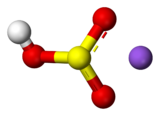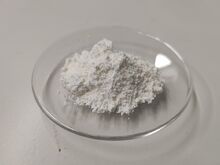ثنائي كبريتيت الصوديوم

| |

| |

| |
| الأسماء | |
|---|---|
| اسم أيوپاك
Sodium hydrogen sulfite
| |
أسماء أخرى
| |
| المُعرِّفات | |
| رقم CAS | |
3D model (JSmol)
|
|
| ChEBI | |
| ChEMBL | |
| ChemSpider | |
| ECHA InfoCard | 100.028.680 |
| E number | E222 (preservatives) |
PubChem CID
|
|
| رقم RTECS |
|
| UNII | |
CompTox Dashboard (EPA)
|
|
| الخصائص | |
| الصيغة الجزيئية | NaHSO3 |
| كتلة مولية | 104.061 g/mol |
| المظهر | White solid |
| الرائحة | Slight sulfurous odor |
| الكثافة | 1.48 g/cm3 |
| نقطة الانصهار | |
| نقطة الغليان | |
| قابلية الذوبان في الماء | 42 g/100 mL |
| معامل الانكسار (nD) | 1.526 |
| المخاطر | |
| ن.م.ع. مخطط تصويري | 
|
| H302 | |
| P301+P312+P330 | |
| NFPA 704 (معيـَّن النار) | |
| نقطة الوميض | Non-flammable |
| حدود التعرض الصحية بالولايات المتحدة (NIOSH): | |
PEL (المسموح)
|
none[1] |
REL (الموصى به)
|
TWA 5 mg/m3[1] |
IDLH (خطر عاجل)
|
N.D.[1] |
| مركبات ذا علاقة | |
أنيونات أخرى
|
كبريتيت الصوديوم بيروكبريتيت الصوديوم |
كاتيونات أخرى
|
بيكبريتيت البوتاسيوم |
ما لم يُذكر غير ذلك، البيانات المعطاة للمواد في حالاتهم العيارية (عند 25 °س [77 °ف]، 100 kPa). | |
| مراجع الجدول | |
بيكبريتيت الصوديوم ويدعى أيضاً بـكبريتيت الصوديوم الحامضية هو مركب كيميائي له الصيغة NaHSO3. له العديد من التطبيقات الصناعية إما على شكل صلب أو محلول. الشكل الصلب يكون غالباً على شكل بيروكبريتيت الصوديوم Na2S2O5 ، والذي هو ناتج نزع الماء (بلمهة) جزيئتي بيكبريتيت الصوديوم.
التحضير
يحضر بيكبريتيت الصوديوم من تمرير 7-8 % من ثاني أكسيد الكبريت خلال المحلول الأم لعمليات سابقة حاوية على كميات ضئيلة من بيكبريتيت الصوديوم في المحلول وكميات معتبرة من كربونات الصوديوم على شكل معلق ، حيث يجري التفاعل التالي:
يتم الحصول على الناتج على شكل معلق، والذي يزال من المحلول عن طريق التثفيل .
الاستخدامات
- يدخل في العديد من التفاعلات الكيميائية العضوية مثل سلفنة الألدهيدات وبعض الكيتونات الحلقية.
- يستخدم كمادة حافظة للغذاء E 222 .
- يستخدم في معالجة المياه والتحكم في التلوث كمادة مضادة للـكلور.
- يستخدم في الدباغة كـعامل مرجع لمحاليل الكروم.
- يستخدم للقصر في الصناعات النسيجبة.
مستحضرات التجميل
The safety of cosmetic products is constantly in question as the components are always changing or being discovered as a possibly harmful substance. The sulfite components of cosmetic ingredients, such as sodium bisulfite, underwent clinical trials to find out their safety in cosmetic formulations. Sodium bisulfite functions as a reducing agent and furthermore as a hair-waiving/straightening agent.[2] As of 1998, sodium bisulfite was used in 58 different cosmetic products including hair conditioners, moisturizers, and hair dyes.[3]
In a cosmetic context, the reducing ability of sodium bisulfite is used to prevent discoloration, bleach food starches, and delay spoilage of the product. Since the sulfite molecule was used in so many compounds in the 1990s, the EPA, FDA, and American Conference of Governmental Industrial Hygienists established a working place threshold limit value for sulfur dioxide of 2ppm averaged over 8 hours, and a 3-hour level of 5ppm. Even with this threshold established, the FDA recognized sodium bisulfite as a "generally recognized as safe" compound.[4]
A final examination on the carcinogenicity, genotoxicity, oral toxicity, and cellular toxicity on consumed sodium bisulfite was conducted using living subjects such as mice and rats. The International Agency for Research on Cancer concluded that there was inadequate evidence that sodium bisulfite was carcinogenic.[4] Under specific conditions such as acidity and concentration level, sodium bisulfite was able to cause negative alterations to the genome such as catalyzing transamination, and induce sister-chromatid exchanges suggesting possible genotoxicity.[5] In a study using Osbourne-Mendel strain rats, it was concluded that oral toxicity was not significant if the consumed concentration was less than 0.1% (615ppm as SO2).[6] A study done by Servalli, Lear, and Cottree in 1984 found that sodium bisulfite did not produce membrane fusion in hepatic and murine glial cells and human fibroblasts so there is no oral toxicity. These clinical studies concluded that sodium bisulfite was safe to use in cosmetic formulations.[4]
الصناعات الغذائية
Similar to the cosmetic industry, the European Commission requested the European Food Safety Authority (EFSA) to review and determine if the use of sulfites as food additives was still safe in light of new scientific technology and information. Since sodium bisulfite is a known sulfonating compound, it underwent the experimentation. Based on clinical experiments using rats and mice, the World Health Organization Expert Committee on Food Additives came to the conclusion that 0-0.7mg of sulfur dioxide equivalent/kg of body weight per day will cause no harm to an individual consuming this compound as a food additive. The genotoxicity and carcinogenicity were examined just as in the cosmetic trials and in both cases, no potential for concern with respect to the sulfites were found.[7]
The production of sodium bisulfite used as a food additive can be described by the combination of sulfur dioxide gas with aqueous sodium hydroxide solution in usual absorber apparatuses. In order to analyze the amount of free sulfites in food as a result of the sulfonation of sodium bisulfite, multiple methods can be used including the Monier-Williams type procedure,[8] HPLC after extraction, and Flow Injection analysis. Overall, the use of sodium bisulfite in the food industry as an additive and antioxidant is safe and beneficial to the lifespan of processed foods.[7]
صناعة النسيج
An antichlor is a substance used to decompose residual hypochlorite or chlorine after chlorine-based bleaching, in order to prevent ongoing reactions with, and therefore damage to, the material that has been bleached. Sodium bisulfite is an example of an antichlor. Historically, sodium bisulfite has been used in the textile industry, cosmetic industry, food industry, and more.[4][9]
Antichlors are very useful in the textile industry because bleaching of compounds using chlorine is a standard practice. However, the use of sodium bisulfite in the decomposition of excess hypochlorite can lead to harmful byproducts when it comes into contact with water at the concentrations present for industrial use.[9] Contact with these dangerous byproducts or even strong concentrations of sodium bisulfite can be harmful to the environment and contact with the skin. Strong concentrations of these compounds can contaminate ecosystems, harm animals, and cause contact dermatitis with industrial workers.[9][10] The concentrations that could result in these outcomes are much stronger than the concentrations discussed in the cosmetic and food industry.
انظر أيضاً
- بيروكبريتيت الصوديوم
- Sodium metabisulfite
- Calcium bisulfite
- Potassium bisulfite
- Croscarmellose sodium
- Sulfurous acid
المصادر
shreve´s chemical process industries, fifth edition, ISBN 0-07-057147-3
- ^ أ ب ت NIOSH Pocket Guide to Chemical Hazards 0561
- ^ Leite, Marcella Gabarra Almeida; Garbossa, Wanessa Almeida Ciancaglio; Campos, Patricia Maria Berardo Gonçalves Maia (2018-11-29). "Hair straighteners: an approach based on science and consumer profile". Brazilian Journal of Pharmaceutical Sciences. 54 (3). doi:10.1590/s2175-97902018000317339. ISSN 2175-9790.
- ^ Cherian, Priya; Zhu, Jinqiu; Bergfeld, Wilma F.; Belsito, Donald V.; Hill, Ronald A.; Klaassen, Curtis D.; Liebler, Daniel C.; Marks, James G.; Shank, Ronald C.; Slaga, Thomas J.; Snyder, Paul W. (2020). "Amended Safety Assessment of Parabens as Used in Cosmetics". International Journal of Toxicology. 39 (1_suppl): 5S–97S. doi:10.1177/1091581820925001. ISSN 1091-5818. PMID 32723119. S2CID 220850521.
- ^ أ ب ت ث Nair, B.; Elmore, A. R.; Cosmetic Ingredients Review Expert Panel (2003-06-01). "Final Report on the Safety Assessment of Sodium Sulfite, Potassium Sulfite, Ammonium Sulfite, Sodium Bisulfite, Ammonium Bisulfite, Sodium Metabisulfite and Potassium Metabisulfite". International Journal of Toxicology (in الإنجليزية). 22 (2 Suppl): 63–88. doi:10.1080/10915810305077X. ISSN 1091-5818. PMID 14555420.
- ^ Abe, Syuiti; Sasaki, Motomichi (1977). "Chromosome Aberrations and Sister Chromatid Exchanges in Chinese Hamster Cells Exposed to Various Chemicals 2". Journal of the National Cancer Institute (in الإنجليزية). 58 (6): 1635–1641. doi:10.1093/jnci/58.6.1635. ISSN 1460-2105. PMID 864744.
- ^ Jonker, D.; Woutersen, R.A.; van Bladeren, P.J.; Til, H.P.; Feron, V.J. (1990). "4-Week oral toxicity study of a combination of eight chemicals in rats: Comparison with the toxicity of the individual compounds". Food and Chemical Toxicology (in الإنجليزية). 28 (9): 623–631. doi:10.1016/0278-6915(90)90170-R. PMID 2272560.
- ^ أ ب خطأ استشهاد: وسم
<ref>غير صحيح؛ لا نص تم توفيره للمراجع المسماة:2 - ^ "Reevaluation of Monier-Williams method for determining sulfite in food". Journal of AOAC International. Oxford University Press. Retrieved 2022-09-20.
- ^ أ ب ت Periyasamy, A.P.; Militky, J. (2017) (in en), Denim processing and health hazards, Elsevier, pp. 161–196, doi:, ISBN 978-0-08-102043-2, https://linkinghub.elsevier.com/retrieve/pii/B9780081020432000071, retrieved on 2022-05-11
- ^ Nagayama, Hirotoshi; Hatamochi, Atsushi; Shinkai, Hiroshi (1997). "A Case of Contact Dermatitis Due to Sodium Bisulfite in an Ophthalmic Solution". The Journal of Dermatology (in الإنجليزية). 24 (10): 675–677. doi:10.1111/j.1346-8138.1997.tb02315.x. PMID 9375469. S2CID 21945156.
- Articles with changed EBI identifier
- ECHA InfoCard ID from Wikidata
- E number from Wikidata
- Articles containing unverified chemical infoboxes
- Chembox image size set
- Short description is different from Wikidata
- كبريتيتات
- مركبات الصوديوم
- إضافات غذائية
- كواشف الكيمياء العضوية
- عوامل مختزلة
- مضافات غذائية بأرقام أوروپية
